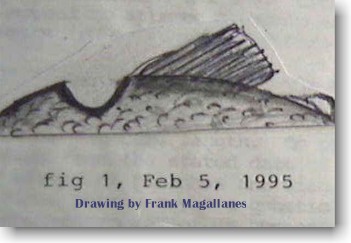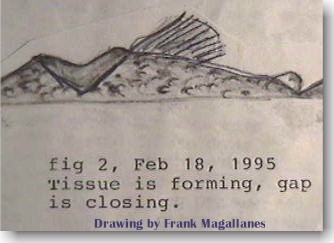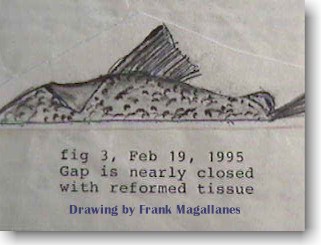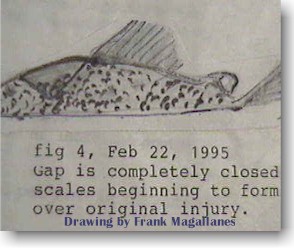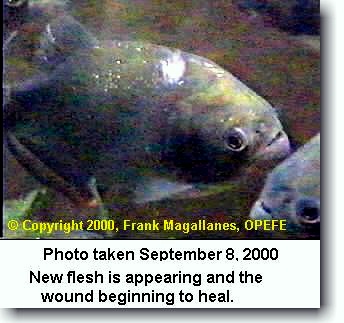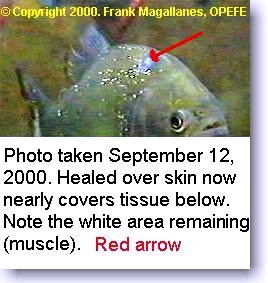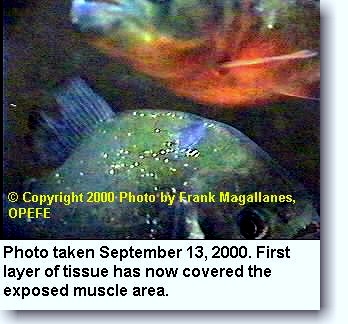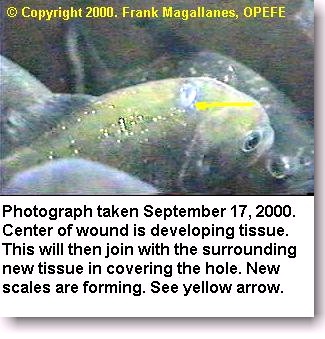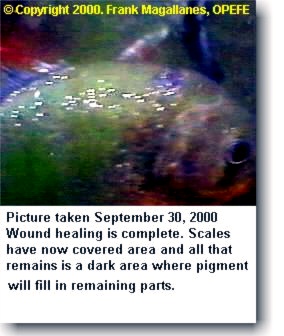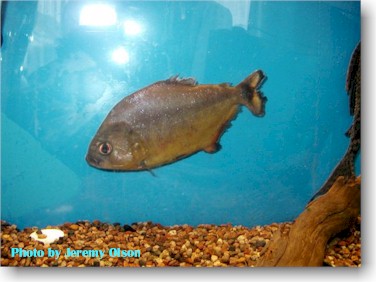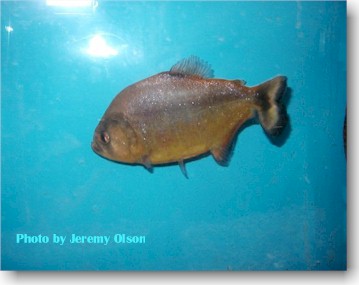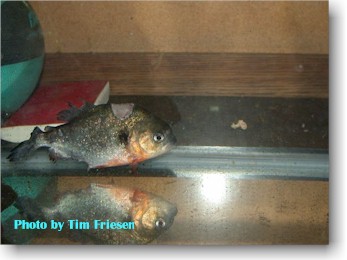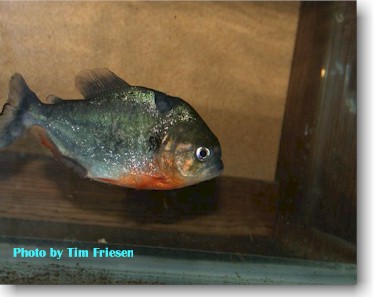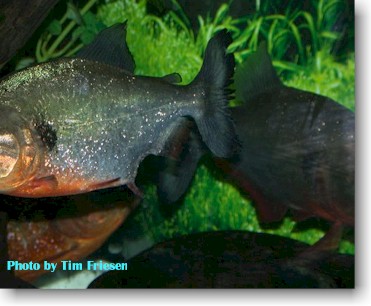Morphallaxis of genus Pygocentrus
(Article first appeared OPEFE Journal of Piranhas and other
predatory fishes)
Issue No. 005-0395 Vol.1 - 1995
With all news images added - September 5, 2000
by Frank Magallanes
Included are 2 new articles on Serrasalmus maculatus and Pygocentrus cariba
FROM FRANK MAGALLANES
The drawings below were made in 1995 of a Pygocentrus nattereri that was bitten on the dorsum.
|
|
|
|
|
Piranhas
having amazing recuperative powers and so far to my knowledge, have not been
examined by the medical profession for potential medical usage. It is however,
my understanding, that some marine fish are being used in experiments for a cure
pertaining to muscular dystrophy.
Bites to the fins usually regenerate within a month, while body bites repair
much quickly as shown above. It is not unusual to find wild caught piranhas with
similar "healed" wounds on body with barely visable circular bites on
the flesh.
BODY REPAIR
Below are current images of a new piranha example (same species) bitten on the right flank upper dorsum. I will be updating these images on a weekly basis to follow the progress of the fishes regeneration.
Top Row:
September 5; the bite damage first appeared. Bite is a circular indentation 9 mm circumference by 1.8 mm deep.
September 8; damaged part beginning to repair itself.
September 11; tissue can been seen very clearly as the wound heals itself.
September 12; tissue is rapidly covering up the muscle area exposed. I expect by this weekend scales should be forming.
Bottom Row:
-
September 13; tissue has now covered the wound.
-
September 18; tissue is forming in the center of the bite. Scales are now filling in surrounding the bite that has been covered over by new tissue.
-
September 24; scales are now cover majority of wound. Indentation still visiable but slowly being covered over by tissue and new layer of bottom skin. Some scales are covering this area
-
September 30; scales have completely covered wound. All that remains is dark area where pigment will gradually fill in (photo below).
INFORMATION PUBLISHED
At the present time, only two published piranha books have covered this topic of piranha flesh regeneration. Piranhas in the Aquarium (Schulte) and Piranhas Fact and Fiction (Quinn) made vague references to the healing process and included some images. None has actually shown the day by day healing process as illustrated above. Bites to a piranhas body heal rapidly. Only vital organs, adipose fin or loss of an eye is not replaced (a few cases the lenses was bit off and regenerated). I have seen an entire caudal fin bitten off with only the stub of the caudal peduncle remaining and the fish regenerated its fin. That in itself is not usual for fishes, but to see entire body heal itself in such a rapid fashion makes this type of study interesting.
In a few reported cases, the belly region was attacked where the anus was removed and the intestines damaged or bit off. The clipped off intestine was regenerated and re-routed to a new opening away from the traditional anus opening, sometimes opened to the side of the fish above the serrae. I hope to find hobbyists photos which show this damage then place photos here.
Fin Regeneration of Serrasalmus maculatus
All photos by Jeremy Olson
Written by Jeremy Olson
I took the first pics on April 14, 2003. He has been really beat on and only in the tank for a few hours when I took this picture. I did water changes around every 3 days or so at 20% and added around 1 tablespoon of salt for every 10 gallons in a 75g tank. The temp was at 84 degrees F.
Body and Fin Regeneration of Pygocentrus cariba - Nov 25 2002
All photos by Tim Fiesen
by Tim Friesen
-
November 4/02: Photo 1 (left, TOP) Here is a pic of my little guy after a very unfortunate attack from an inbred red belly. Note the fins, the bite in the back and the bite in the anal fin, which goes into the body.
-
November 11/02: Photo 2 (right, TOP) Roughly a week and a bit later.
The dorsal and tail are healed, the bite in the back is almost healed, and the anal fin (which i thought would not grow back because of how far the bite was) is coming in. He was in a 10 gallon hospital, with added salt and a temp of 83f. These are amazing fish. I thought for sure he would be pretty deformed, but now he will almost be 100% self-repaired.
REFERENCE
-
Magallanes, Frank, 1995, Morphallaxis of genus Pygocentrus, OPEFE Journal of Piranhas and other predatory fishes, Issue No. 005-0395 Vol.1 Out of Print.
-
Schulte, Wolfgang, 1977, Piranhas in The Aquarium, TFH Publications, Neptune City, NJ
-
Quinn, John R. 1992, Piranhas Fact and Fiction, TFH Publications, Neptune City, NJ
-
Olson, Jeremy, 2003, home hobbyist
-
Tim Friesen, 2002, home hobbyist
-
Galliot, B. (1997). Signaling molecules in regenerating hydra. BioEssays 19, 37-46.
-
Goss, R.J. (1991). The natural history (and mystery) of regeneration. In A History of Regeneration Research (ed. C. E. Dinsmore), pp. 7-23. Cambridge University Press, Cambridge.
-
Morgan, T.H. (1898). Experimental studies of the regeneration of Planaria maculata. Arch. Entw. Mech. Org. 7, 364-397.
-
Morgan, T.H. (1901). Regeneration. Macmillan Co., New York
USE YOUR BACKSPACE TO RETURN OR CLICK HERE TO RETURN RESEARCH PAGE
TO RETURN HOME CLICK HERE.
The OPEFE web site and its contents; is disclaimed for purposes of Zoological Nomenclature in accordance with the International Code of Zoological Nomenclature, Fourth Edition, Article 8.3 and 8.4. No new names or nomenclature changes are available from statements at this web site.
Copyrightę 1994-2012 Oregon Piranha Exotic Fish Exhibit (The OPEFE fish exhibit is permanently CLOSED as of 2000) Sutherlin, Oregon. Information posted on this web site is archival data on fish scientific classifications and other information. DISCLAIMER: The copyrighted material may not be used for any purpose other than private study, scholarship or research. Cited information requires credit and this link www.opefe.com. All rights reserved. All images shown (unless otherwise noted) is property of OPEFE.
